Spoilers follow for Game of Thrones, Rembrandt’s 1632 painting The Anatomy Lesson of Dr. Nicolaes Tulp, and Pietás (all of them).
In its second week, Season 6 of Game of Thrones continues its commitment to big reveals in the last scene. Last week it was Melisandre; this week, Jon Snow was in the crosshairs. The same creative team worked on this episode—director Jeremy Podeswa, cinematographer Gregory Middleton, and editor Crispin Green—but they used a completely different bag of tricks. Melisandre’s reveal was accomplished with rack focus, an elegant trick with a mirror, and an even more elegant trick with the audience’s expectations for Game of Thrones nudity. But this week was all about blocking and camera movement.
The scene has three sections, each with its own grammar: the preparations for Melisandre’s ceremony, the ceremony itself, and the aftermath. The preparations begin with an insert of Melisandre wringing out a washcloth over a basin:
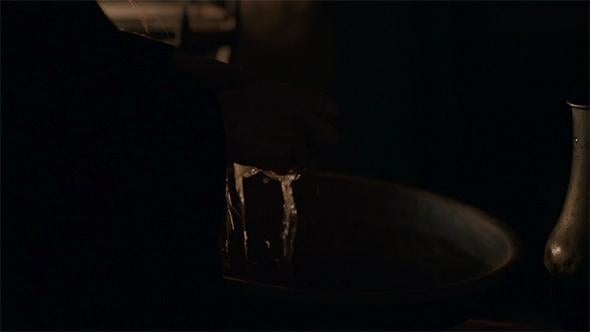
HBO
The camera then pans left to follow the washcloth across her body as she moves toward Jon Snow:

HBO
On the next shot we’re looking at Snow’s body:
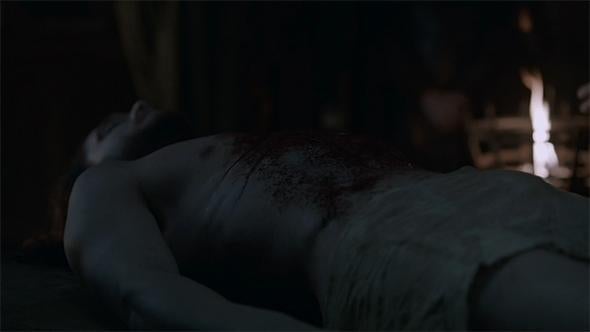
HBO
Before tracking up to put Melisandre back in frame. In the background, Davos and Dolorous Edd are visible but out of focus:

HBO
That’s how this section goes—the camera is almost always moving, although not very dramatically, and its movement follows objects, not people: the cloth, the scissors, the pitcher. It even tracks down when water drips from Jon’s hair into a bucket, as if gravity were more interesting than anything anyone in the room was doing. There are a few shots of Davos casting a skeptical eye toward, we initially presume, Melisandre:
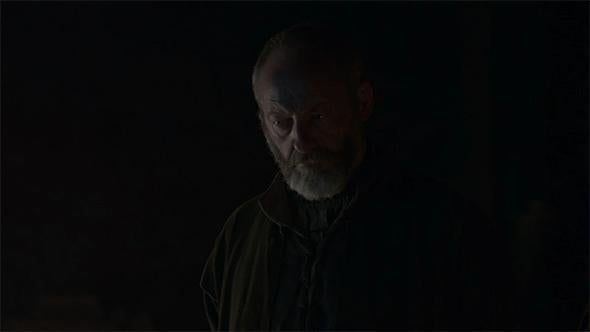
HBO
But the focus quickly shifts to reveal he is staring at a lock of hair or a pitcher:

HBO
The key here is there’s no interaction. Only one person’s face is in focus in any one shot, the camera never moves from one face to another, and although Melisandre casts her eyes toward Davos nervously a few times, there’s no eye contact bat all. Viewers have the sense—as Melisandre does—of Davos, Dolorous Edd, and Tormond as looming presences but not people. In fact, as the wide shot that opens the next section reveals, they aren’t even standing where people would:
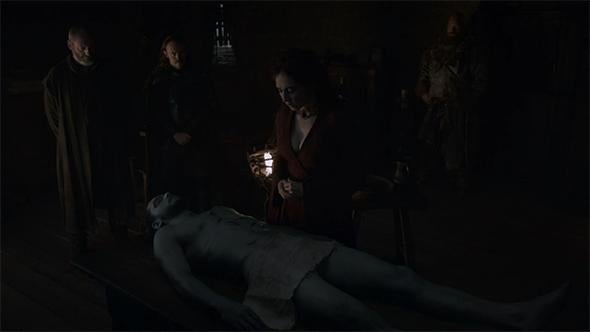
HBO
The actors are arranged in the room so that no one’s eyeline will cross anyone else’s; the entire arrangement is a little unnerving. Melisandre is possibly about to raise the dead, but no one wants a better view, and Tormond is okay with standing way on the other end of the room, with no clear view of the table. The blocking resembles what you’d see in a play rather than a film—or really any medium where the audience’s point of view can’t move around the room freely. Like, for instance, a painting:
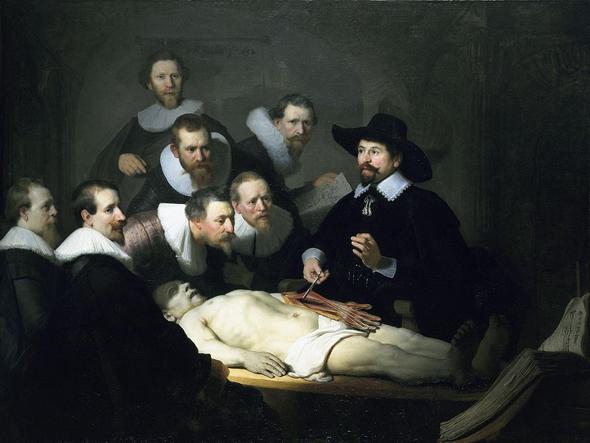
Rembrandt van Rijn/Wikimedia Commons
Using that particular painting as a visual reference doesn’t seem like good news for the man on the table. But before the odd blocking really registers, much less the Rembrandt allusion, the scene moves into the second section. As Melisandre begins the ceremony, we get inserts following the action, as before—but now she’s using her hands, not tools:
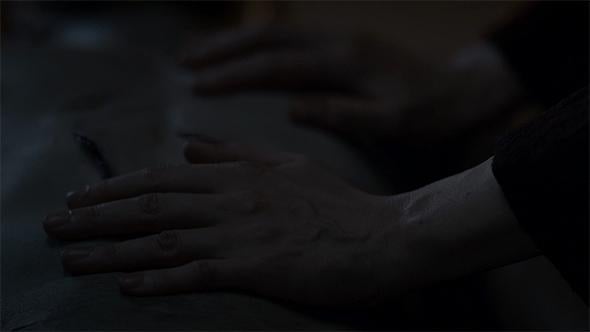
HBO
In the second section, the camera will follow people, rather than objects. Podeswa then gives us the first rack focus that moves from one face to another—except it’s from Jon Snow’s to Melisandre’s, and the look they share communicates nothing except, “Yeah, still dead down here.”

HBO
As Melisandre realizes her spell isn’t working and starts panicking, the camera does a slow, cruel push-in on her face, and then, three minutes into the scene, we get the very first communication between living characters, courtesy of a rack focus. It’s not great news for Melisandre:
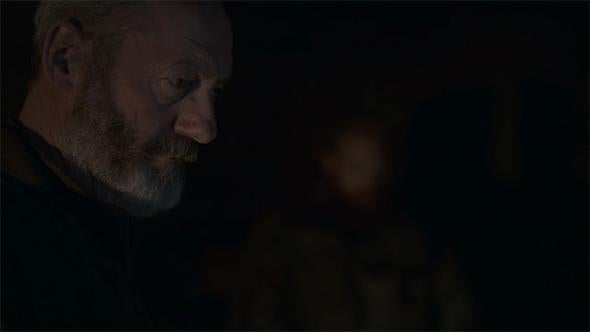
HBO

HBO
Note, incidentally, how much the blocking has changed from the wide shot to facilitate this look between Davos and Tormond: Spatial continuity is wildly overrated. After a few shots that connect Melisandre and Jon Snow’s faces—he’s deader than ever—she finally makes eye contact with Davos:
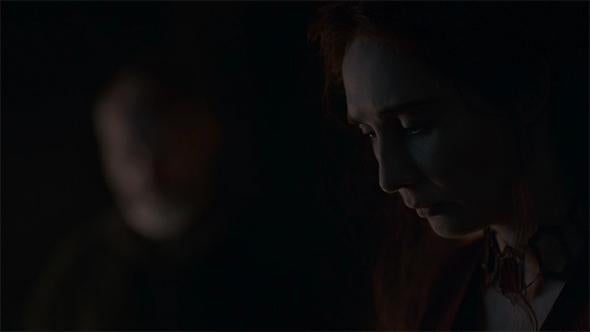
HBO

HBO
And then another first: a reverse shot, the first time Podeswa’s registered enough of a connection between characters for both people’s perspective to matter.
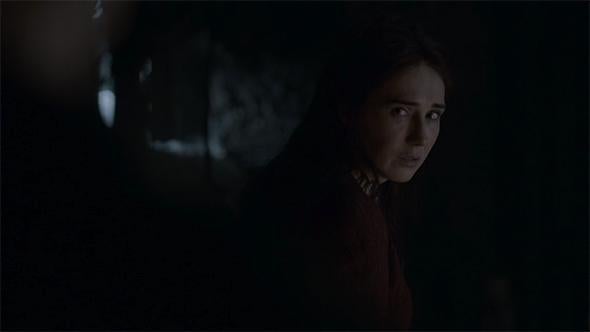
HBO
It’s the most devastating shot in the scene—Melisandre looks more defeated than she did in the last episode. And why wouldn’t she? She was alone then; now she’s failing in front of an audience. Whatever spell was in the room breaks—Tormond storms out but before the rest of the crowd follows, Podeswa takes a moment to turn his Anatomy Lesson into a Pietá:

HBO
It’s all a matter of camera angles. The final section, the actual John Snow reveal, after all that, is pretty anticlimactic. After moving the camera at least a little in almost every shot in the scene, Podeswa suddenly locks it down, giving us static, symmetrical shots where nothing happens at all:

HBO
Untill, of course, the jump scare that closes the episode. It’s fine as an ending, but what makes the scene work is the careful blocking and camera work that builds up to it. By blocking the scene in an unnatural way (and concealing how odd it is by not using wide shots for a very long time) Podeswa and his team visually isolate everyone but particularly Melisandre. The only thing she’s allowed to communicate is that she’s failed. It’s the scene’s mounting sense of isolation and failure, more than any jump scare, that makes Jon Snow’s sudden revival such a shock.